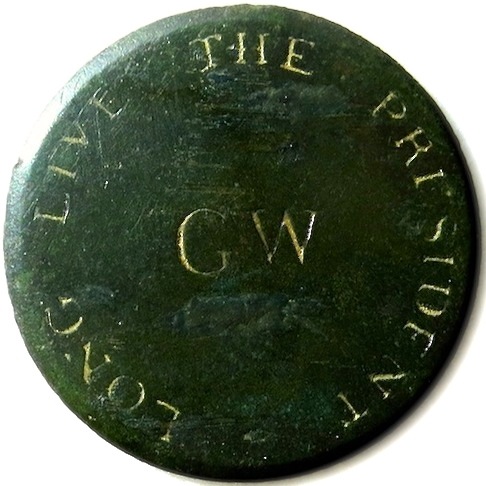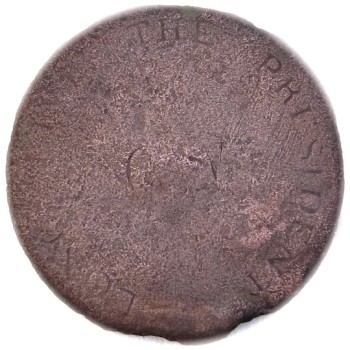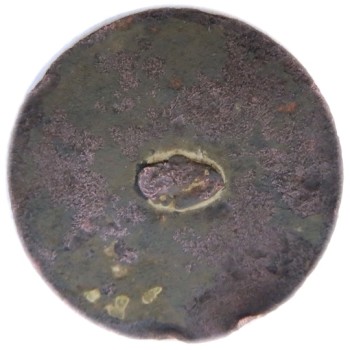~ GWI 8 ~
The Plain Roman Font “GW” Monogram Center
*
**In the last year several counterfeit specimens have showed up in the West Coast of the united states showing faked patina age and damage, but are claimed to be un-dug heirlooms. Buyers Beware this is the easiest variant for forgers to make. Grain Weight must be checked!
GWI 8-A & B THE PLAIN ROMAN “GW” MONOGRAM CENTER: As with all George Washington Inaugurals and New Nation Tribute buttons the design was hand engraved in a round steel die hub, and then fired to hardness through the action of a furnace. Afterwards it was sent to a manufacturer in England and stamped into a blank metal brass planchet. After the die fabrication, a Gold-Wash was brushed on and the fired in an oven to set the finish.
Most GWI 8 specimens are Dug, and Un-Dug specimens are with a Good Hard Strike are rare. There is no indication of any hidden Scottish Tribute markings within this button. This is also no signature marks that Robert Scot or his Philadelphia artisans made this button. Meaning, this button most likely was produced later in 1792/3 for Washington’s second inaugural celebration by other engravers. There are two known die variants for this pattern. The first is GWI 8-A, which has a Wide “W” for the GW Monogram. The second is GWI-B, which has a Narrow “W” for the GW Monogram. Since, a handful of unrecorded specimens have surfaced in the last few years, I am going to give both GWI A & B an R-5 Rarity Rating. From my cataloged site records on known specimens to exist, I found that most surviving specimens are GWI 8-A variant which depicts the Wide, “W” for the GW monogram. The Size for both GWI 8-A & B buttons is a large 36mm. This appears to be the largest size inaugural button made.
Unlike all the other GWI buttons, this button is fashioned with the only known beveled edge. This tells me some engraver made a “unique notable hallmark” to their steel die cut. GWI 8 is a One-Piece button with a soldered on loop shank. GWI 8 A & B features a plain medium-size Roman font “GW” Monogram stamped in the center. Circling around the legend is a slight variation to the salute Chancellor Robert Livingston gave after he administered the oath of office to Washington. It is recorded that he shouted to the crowd of on-lookers, “Long Live George Washington, President of the United States!” This was then followed by the crowds cheers, and a 13 gun salute. What this tells me is that this button could not have been made prior to the inauguration day, and would have been made months or years following the inauguration to commemorate Washington during his year long tour through the states. GWI 8-A & B, as with all George Washington inaugural buttons depicts a slight variation to Livingston’s salute,”LONG LIVE THE PRESIDENT.” GWI 8’s slogan is in all Roman Font capital letters. Lastly, in the six o’clock position in the bottom legend is the depiction of an incuse Arrow Tip pointing directly up to the GW monogram. I believe the arrow point was giving meaning the slogan’s by pointing to George Washington. This would have been inline with the intent of the country’s sentiment.
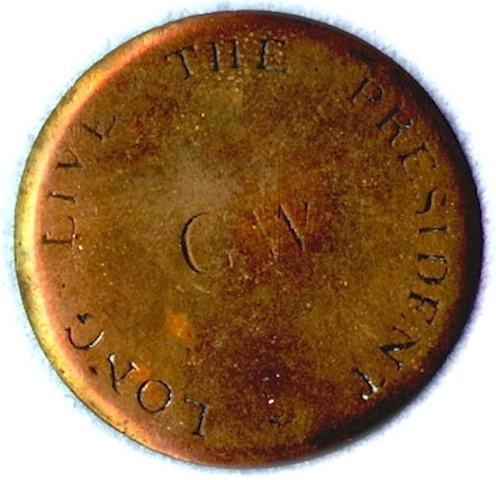
GWI 8-A THE PLAIN ROMAN “GW” MONOGRAM CENTER
Color: A Mustard Brown.
Metal: Flat, 1-Piece, Stamped Design Pattern, Gold-Wash Brass.
Size: 36.8mm. Inaugural Size.
Rarity: R-5.
Variety Type: Wide W.
Present Condition: A Non Excavated Specimen, A Strong Planchet Condition Remains, A Strong Impression Remains.
Obverse Button Analysis: This buttons is one of the best surviving specimens. It still has an attractive surface, and still strong imprint impressions. The brass planchet appears to be smooth and flat, and shows no waviness or shallow depressions in the metal’s planchet. The surface does show a few light scratches and scuffs, but age seems to have blended them in with the buttons surface color. The Roman font letters for the wide “GW” Monogram only show a strong foot print for this variant. All the monogram letters lines are easy to see. The Roman font capital letters in the slogan still show a good image with a nice impression. Collectors should note all the stamped “E‘s” in the Slogan appear to have weak stamped tops and bottom stems. The incuse Arrow Tip in the bottom legend only depict the slightest remnant. Since this particular variety is known for weak die strikes, this seems to be a good solid un-dug example for a collector to buy at any cost.
Reverse Button Analysis: This is a one-piece button with a soldered on loop shank. The shank is original, straight and still intact. It was reported to have very minor abrasions to the surface.
Library Records Has Limited Information WI 8 A-1:
History: Yes Recorded Sales Price: Yes
Current Button Owner and Location: No
Harold Cobb/Descendants 1956 to 2003
Purchased from S. Luscomb in 1955.~
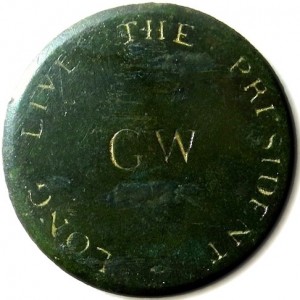
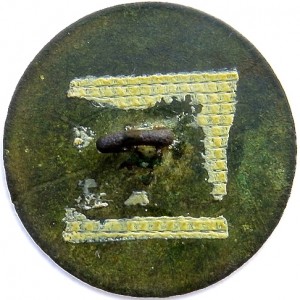
GWI 8-A THE PLAIN ROMAN “GW” MONOGRAM CENTER
Color: An Emerald Green W/ Gold Highlights.
Metal: Flat, 1-Piece, Stamped Design Pattern, Gold-Washed Brass.
Size: 36.20mm. Inaugural Size.
Rarity: R-5.
Variety Type: Wide W.
Present Condition: An Excavated Specimen, A Strong Planchet Condition Remains, An Exceptional Impressions Remains.
Obverse Button Analysis: This button just has an amazing Emerald Green Colour that is consistent across the surface. This button has the best imprints out of all surviving “dug” specimens. The brass planchet is smooth to the touch and has no waviness to the planchet. There are a few minor facial scuffs to the face, but nothing that takes away from the button’s charm. The Roman Font Capital letters in the legend’s Slogan still has a strong impression, and has a good clear image of all the letters. As noted earlier, all GWI 8 specimens, have weak strikes for the top and bottom stems of the letter “E.” The incuse Arrow Tip in the bottom legend still has a good image and impression.
Reverse Button Analysis: This is a one-piece button with a soldered on loop shank. The shank is original, straight and intact.
Library Records Has Limited Information WI 8 A-2:
History: Yes Recorded Sales Price: Yes
Current Button Owner and Location: ~ New Windsor ~
Dug in Rockingham North Carolina in 1990 by Mr. Moore.~
The Isabela Collection~


GWI 8-A THE PLAIN ROMAN “GW” MONOGRAM CENTER
Color: A Silvery Brown.
Metal: Flat, 1-Piece, Stamped Design Pattern, Gold- Wash Brass.
Size: 36.5omm. Inaugural Size.
Rarity: R-5
Variety Type: Wide W.
Present Condition: A Non Excavated Specimen, A Strong Planchet Condition, A Strong Impression Remains.
Obverse Button Analysis: This button is one of the Top 3 “un-dug” specimens (known to me at this time). The button’s surface color is even, and the planchet shows no sign of metal fatigue or deterioration. There is a slight light green tone Verdigris areas from humidity / temperature on the outer beveled edge between LONG and LIVE, and some subtle hints carry onto the reverse. But overall this does not detract in anyway from it’s pleasing consistent color. The Roman font letters for the wide “GW” Monogram are deeply struck, and show clear letters lines. The slogan has a good clear image, and show a strong strike with the best letter “E” strikes from all the specimens I studied. The image of the incuse Arrow Tip in the bottom legend is razor sharp with a nice strong strike.
Reverse Button Analysis: Reverse Button Analysis: This is a flat one-piece button with a soldered on loop shank. The shank is original, straight and intact. The surface is mostly smooth, and free of any harsh scratches or abrasions.
Library Records Has Limited Information WI 8 A-3:
History: Yes Recorded Sales Price: Yes
Current Button Owner and Location: No
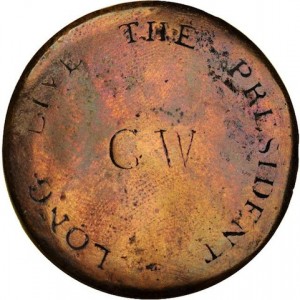
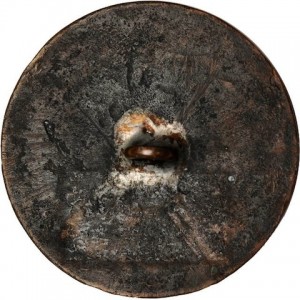
GWI 8-B THE PLAIN ROMAN “GW” MONOGRAM CENTER
Color: An Iridescent Yellow-Chocolate with An Overwhelming Reddish Orange Mix.
Metal: Flat, 1-Piece, Stamped Design Pattern, Gold-Washed Brass.
Size: 36.8mm. 150.6 grains
Rarity: R-5.
Variety Type: Narrow W.
Present Condition: A Non Excavated Specimen, A Strong Planchet Condition Remains, A Strong Impressions Remains.
Obverse Button Analysis: This non-dug specimen shows an iridescent quality to it’s colour. Unfortunately, this tells me that the button was improperly cleaned since it’s last sale in 2003. I believe a chemical may have changed the natural patina of the metal’s original finish. The brass planchet surface is flat, but has some verdigris spots on the metal. The surface has no scratches or abrasions to speak of, but does have some minor micro porosity spots on the face along with some around the edges. The Roman Style letters for the “GW” Monogram has a good readable image with strong letter impressions. The letters in the legend’s slogan shows a slightly deeper impression then the monogram, but some of the letters in “LIVE” were worn smooth into the surface.The incuse Arrow Tip on the bottom legend only has a remnant outline. In the end, the results of the cleaning show more viewable letter impressions since Sunday & Cobb owned it, but the cleaning definitely changed the metals natural colour.
Reverse Button Analysis: This is a flat one-piece button with a soldered on loop shank. The shank is re-soldered on, and shows to be straight and still intact. The surface shows scorch marks, porous areas, and metal decay unfortunately.
Library Records Has Limited Information WI 8 A-4:
History: Yes Recorded Sales Pric Yes
Current Button Owner and Location: No
Harold Cobb/Descendants 1956 to 2003
Purchased from W.F. Sunday in 1956.~
In the early 1940’s, during renovation work on the Southampton, Massachusetts public library, and old tree was cut down and out of one of its limbs fell a hand woven linen bag containing five Cobb 11a’s. Three had shanks and two did not. The group was sold to a local resident, who sold them to button collectors who heard about the find. The Cobb piece is from this unusual find.
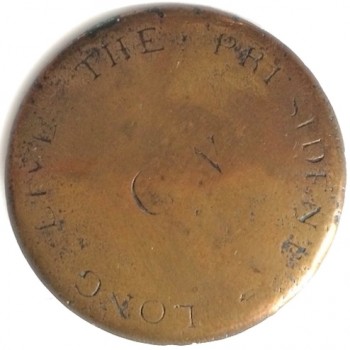
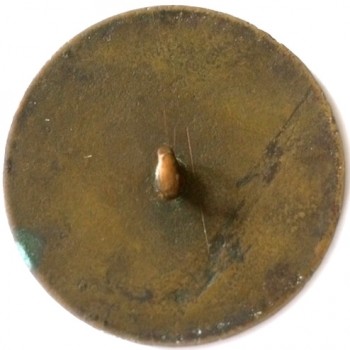
GWI 8-A THE PLAIN ROMAN “GW” MONOGRAM CENTER
Color: A Two-Tone Brass.
Metal: Flat, 1-Piece, Stamped Design Pattern, Brass.
Size: 35mm. Inaugural Size.
Rarity: R-5
Variety Type: Narrow W.
Present Condition: An Excavated Specimen, A Good Planchet Condition Remains, A Strong Impressions Remains.
Obverse Button Analysis: This button is in good condition and has been kept as a family heirloom by Josephine Dewey. Her family had passed this down an heirloom to her grandson Don Walsh. The button’s planchet is flat, and shows no sign of metal fatigue or deterioration. The obverse’s surface appears smooth, and shows only a few light abrasions. For the most part, the natural olive brown color is consistent over the whole surface. The Roman Style letters for the wide “GW” Monogram only shows half the letters. The Roman font capital letters in the slogan have a good image with the exception of the word “LIVE” and the “E & S” in President. The incuse Arrow Tip on the bottom only has a remnant foot print.
Reverse Button Analysis: This is a flat one-piece button with a soldered on loop shank. The shank is original, straight, and intact.
Library Records Has Limited Information WI 8 A-9:
History: Yes Recorded Sales Price: Yes
Current Button Owner and Location: Yes
The Don Walsh Collection.~
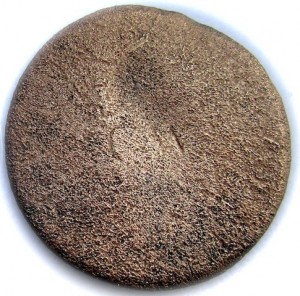

GWI 8-A THE PLAIN ROMAN “GW” MONOGRAM CENTER
Color: A Very Light Sandy Brown With Black Speckles.
Metal: Flat, 1-Piece, Stamped Design Pattern, Brass.
Size: 36.4mm. Inaugural Size.
Rarity: R-5
Variety Type: Narrow W.
Present Condition: An Excavated Specimen, Poor Planchet Condition, A Poor Impressions Remains.
Obverse Button Analysis: This button was sand blasted with glass to reach under the corrosion to get at the design. The brass planchet is wavy, and has an indent on the edge at the one o’clock position. The button decayed surface has an extreme porous nature. The Roman font letters for the “GW” Monogram’s image still has a visible outline. Most of the letter’s strength is shown in the back arc of the G, and there are two visible lines in the W. The Roman font capital letters in the legend’s slogan is almost completely absent. The incuse Arrow Tip is completely worn away from the bottom legend. If your a Serious GW Collector, you would need to unfortunately consider this button for your collection because of limited number of specimens known.
Reverse Button Analysis: This is a flat one-piece button with a soldered on loop shank. The shank is harshly broken off. The surface is course with signs of corrosion, pitting and porosity.
Library Records Has Limited Information WI 8 A-5:
History: Yes Recorded Sales Price: Yes
Current Button Owner and Location: ~ Oklahoma~
The Gray Collection.
Previously the Isabela Collection.~
*One of two excavated in Madbury, New Hampshire in March 2011.~
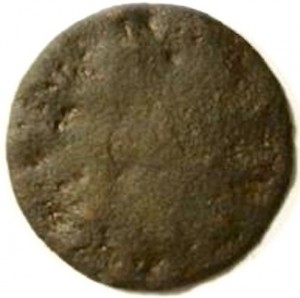
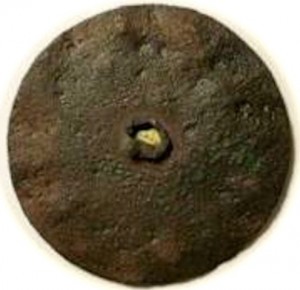
GWI 8-A THE PLAIN ROMAN “GW” MONOGRAM CENTER
Color: A Dark Chocolate Brown.
Metal: Flat, 1-Piece, Stamped Design Pattern, Brass.
Size: 36.1mm. Inaugural Size.
Rarity: R-5
Variety Type: Wide W.
Present Condition: An Excavated Example, A Poor Planchet Condition, A Poor Impressions Remains.
Obverse Button Analysis: This button has definitely seen better days. The brass planchet is extremely pitted and wavy. The surface shows heavy corrosion, porosity, and shallow depressions. The outer edge appears to have been a target for a BB-gun…lol The Roman Font letters of the “GW” Monogram are almostly completely worn smooth into the surface. There are remnants of a slight outline foot print for the “GW“. Giving it’s biggest readable strength to the back arc of the G, and two of the lines in the W. The Roman font capital letters for the slogan is almost completely absent and unreadable, except for the faintest outlines for the word President. The incuse Arrow Tip is completely missing from the six o’clock position.
Reverse Button Analysis: This is a flat one-piece button with a soldered on loop shank. The shank is present, but bent over. The surface is course with signs of corrosion, pitting and porosity.
Library Records Has Limited Information WI 8 A-6:
History: Yes Recorded Sales Price: Yes
Current Button Owner and Location: No
The second one that was excavated in Madbury, New Hampshire in March 2011.~

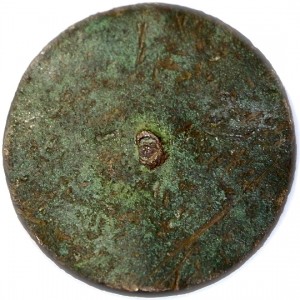
GWI 8-A THE PLAIN ROMAN “GW” MONOGRAM CENTER
Color: Environmental Green with Rusty Patches.
Metal: Flat, 1-Piece, Stamped Design Patten, Brass.
Size: 36mm. Inaugural Size.
Rarity: R-5
Variety Type: Wide W.
Present Condition: An Excavated Example, A Poor Planchet Condition Remains, A Poor Impressions Remains.
Obverse Button Analysis: It is nice to have found another surviving specimen, I just wish the button wasn’t in such rough shape. The brass planchet is no longer smooth or flat. Unfortunately the obverse has multitudes of shallow depressions and raised bumps throughout the surface. In several areas the planchet appears wavy and irregular. We can see from visual examination that the planchet exhibits corrosive properties which led to metal decay and deterioration. This most likely is the result of natures elements from being buried for over a hundred years. The Roman font letters for the “GW” Monogram still show a light foot print for the outline, but is still readable. Most of the “G” monogram’s letter strength is shown in the back arc of the G, and the monogram’s “W” depicts two visible moderate strike lines for the W. The Roman font capital letters in the slogan that circles around the outside legend is almost completely absent, except for, “LONG” and ,”TH” in THE. Only the faintest remnant image remains for the word “President“. The incuse Arrow Tip is completely worn away from the bottom legend. If your a GW Collector, you would need to unfortunately consider this button for your collection at a fair price only because of the limited number of specimens known.
Reverse Button Analysis: This is a flat one-piece button with a soldered on loop shank. The shank is harshly broken off. The surface is course with signs of corrosion, pitting and porosity.
Library Records Has Limited Information WI 8 A-7:
History: Yes Recorded Sales Price: No
Current Button Owner and Location: ~ Delaware ~
*This was found by a girl on a farm in Milton Delaware along a clamshell driveway.
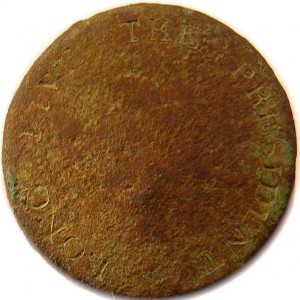

GWI 8-A THE PLAIN ROMAN “GW” MONOGRAM CENTER
Color: A Very Light Sandy Brown With Black Speckles.
Metal: Flat, 1-Piece, Stamped Design Pattern, Brass.
Size: 36.4mm. Inaugural Size.
Rarity: R-5
Variety Type: Narrow W.
Present Condition: An Excavated Specimen, A fair Planchet Condition, A Fair Impressions Remains.
Obverse Button Analysis: This button is what you would expect from being buried for 200+ years. The brass planchet is slightly wavy, and has a slight indent on the edge at the one o’clock position. The button exhibits a decayed surface that is extreme porous in nature. The “GW” Monogram is unrecognizable. The legend’s Slogan is the button’s strong point, giving a decent image to most of the letters. The incuse Arrow Tip has a remnant foot print. If your a Serious GW Collector, you would need to consider this button if it comes up for sale. There is only 9-10 known specimens.
Reverse Button Analysis: This is a flat one-piece button with a soldered on loop shank. The shank is original, bent, but intact.
Library Records Has Limited Information WI 8 A-8:
History: Yes Recorded Sales Price: Digger Owner
Current Button Owner and Location: ~ New York ~
Dave Lofgren Collection.
Dug in November 2013 on a Farm in Rome New York.
GWI 8-A THE PLAIN ROMAN “GW” MONOGRAM CENTER
Color: A Very Light Sandy Brown With Black Speckles.
Metal: Flat, 1-Piece, Stamped Design Pattern, Brass.
Size: 36.40mm.
Rarity: R-5
Variety Type: Narrow W.
Present Condition: An Excavated Specimen, A Fair Planchet Condition, A Fair Impressions Remains.
Obverse Button Analysis: This button was dug along the Manasquan River in the early 1980’s. The Roman font letters for the “GW” Monogram still show a light foot print, but has a shank protrusion from the reverse. The strength of the letters being in the back of the “G” and the right line-up of the “W.” The Roman font capital letters in the Slogan is the button’s strong point. The incuse Arrow Tip is unfortunately faded from the bottom of the legend. If your a Serious GW Collector, you would need to consider this button to make a collection. There is only 9-10 known specimens to exist.
Reverse Button Analysis: This is a flat one-piece button with a soldered on loop shank. The shank is crushed inwards.
Library Records Has Limited Information WI 8 A-9:
History: Yes Recorded Sales Price: Yes
Current Button Owner and Location: ~ Maine ~
Dug in New Jersey by the Manasquan River by Ken L.
The LightBown Collection.
* There is reported information that two others have been found. One in a garden and one dug on a Beach.~
